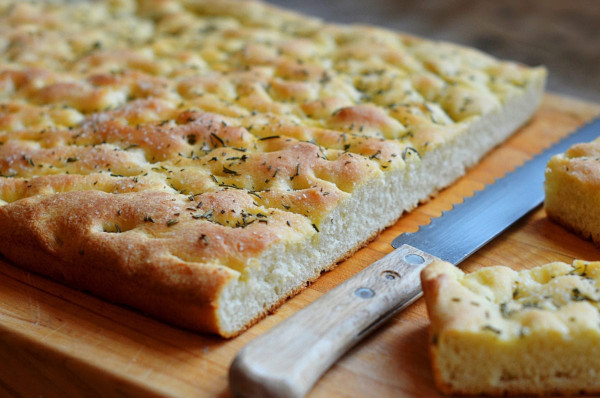Here’s an idea inspired by Egg McMuffin clones that uses something other than an English Muffin as a base. It leverages the best of the basic, McM tradition and delivers a colossal range of new hand food possibilities that are both familiar and fresh…
 Beautiful, hand pressed, finger-poked herb-garnishedFocaccia: Work the dough out thin so its
Beautiful, hand pressed, finger-poked herb-garnishedFocaccia: Work the dough out thin so its
final thickness after baking is no more than about 1.5 cm. Perfect for a no-slice bun half…
A little history
The official story has it that the now legendary Egg McMuffin was created by McFranchisee Herb Peterson in Santa Barbara, California, in 1971. But it was a far cry from what we know as a McM today. In Fact, it was more like an Egg Benedict. And it was simply one guy’s idea of what the anchor item might be for a new McDonald’s Breakfast Menu some owner/operators had been talking about since the year before.
Here’s something you probably didn’t know: The Egg McMuffin concept we know today did NOT spring to life fully developed. It was in fact 1975 before the concept was perfected. The first ‘model’ to be tested was ‘an open-faced sandwich, served on a small tray with honey or jam’ and cost $0.63.
Today, the average price of an Egg McM across the U.S. is $2.79. A top-of-the-line Sausage McMuffin with Egg is $2.99. The Biscuit-based equivalents are tagged about the same.
Spawned a whole slew of copy-cats
It was inevitable that something as new and original and innovative as the McMuffin would trigger the speedy ap0pearaqnce of other, similar menu items at McD’s competitors. Soon they all offered their own takes on the original McM. And a new ‘standard’ (Breakfast) was set for the Fast Food sector. You had to serve Breakfast if you really wanted to be considered a player.
TheMcMuffin comes home
One huge but often overlooked thing the Internet has done for the food scene in general is, it’s promoted the ‘fan’ art’ movement dedicated to coming up with the most perfect home-made version possible of famous big-chain faves. The McMuffin is no exception. In fact, it was one of the first iconic grab-and-go foods to get the ultimate compliment. And there are thousands of web pages out there sharing tips and tricks about making the best home-cloned McM. (See photo, top of page.)
More to the point of my post today is the extension of the ‘homemade version’ movement to include the heartfelt need among influencers to suggest their own improvements to the classics. I take most of them with a grain of salt . (As if McDonald’s savoury menu items items needed more salt!)
But I’ve been intrigued by some of the optional ingredient swap-outs that have come out of the fan movement.
Another English Muffin substitution
Were you as intrigued as I was when some commercial bakeries introduced the Thin Burger Bun concept? It was supposed to be less filling, less caloric and easier to eat than the original dome-topped version.
Once tuned to that idea, I started noting the hordes of traditional dishes from other cuisines using their versions of the flatbread as a bun/wrap. Take a moment… How many sandwiches and other hand foods have you come across that were wrapped in some kind of bread? From Pitas to Chalupas to Tacos to Banh Mis…
After a decade of yawning my way through posts about burgers presented as ‘wraps’, and hot dogs rolled up like enchiladas, I finally came upon a really good idea: A breakfast Sandwich engineered like a McM. Western Sandwich on a bun. And that was followed soon by versions of other classic breakfast treats piled on buns or English Muffins, topped with a slice of American (Processed) Cheese.
My idea…
Now, I’ve come up with what I think is a truly original idea: A Breakfast Sandwich on a cousin to the ‘thin’ burger bun.
Except, my version uses my own Focaccia bread as both top and bottom buns. And I hand-form the buns, or use a big round cookie cutter (or make large, flat rectangular pan loaves I’ll cut into quares after baking) very thin so they’ll end up no more about 1.5 cm thick when baked. I decided that would be better than trying to slice something that’s so thin already like a bagel. Besides I want the Buncaccia to be slightly crispy on the outside (top) and light and fluffy inside, yet still thin. The idea is that the bottom ‘crust’, (as such) well give the otherwise delicate bun enough structural integrity to withstand usual burger-style handing.
Focaccia recipes to try
Here’s my own Focaccia recipe with all the tips and hacks and so 0n included. And here’s an appropriately-titled recipe for ‘Shockingly Easy No-Knead Focaccia’ you can use to further streamline the already easy traditional Focaccia recipe.
Make sure you DO poke the dough with your fingertips as instructed but DON’T pierce with a fork, as some other recipes recommend. We want our Buncaccias to come out crispy on the outside but light and fluffy on the inside – not stiff or dry.
Tradition says you can season or garnish the top of Focaccia bread with almost anything you fancy. I often think of sliced or chopped olives, freshly chopped garlic, fresh herbs, bacon crumbles, various Pizza toppings, Middle Eastern Za’atar, grated hard cheese (like Parmisan)… Whatever strikes your fancy. What’s more, you can work lots of different additions right into your Focaccia during mixing and kneading.
Open your mind…
I also see my Buncaccia as coming in a full range of ‘flavours’, from Whole Wheat to Everything, as the user’s wishes and proposed fillings dictate. But start with the traditional round egg, matching round sausage patty and iconic American Cheese slice – so you can compare it fairly with the original McM.
~ Maggie J.

